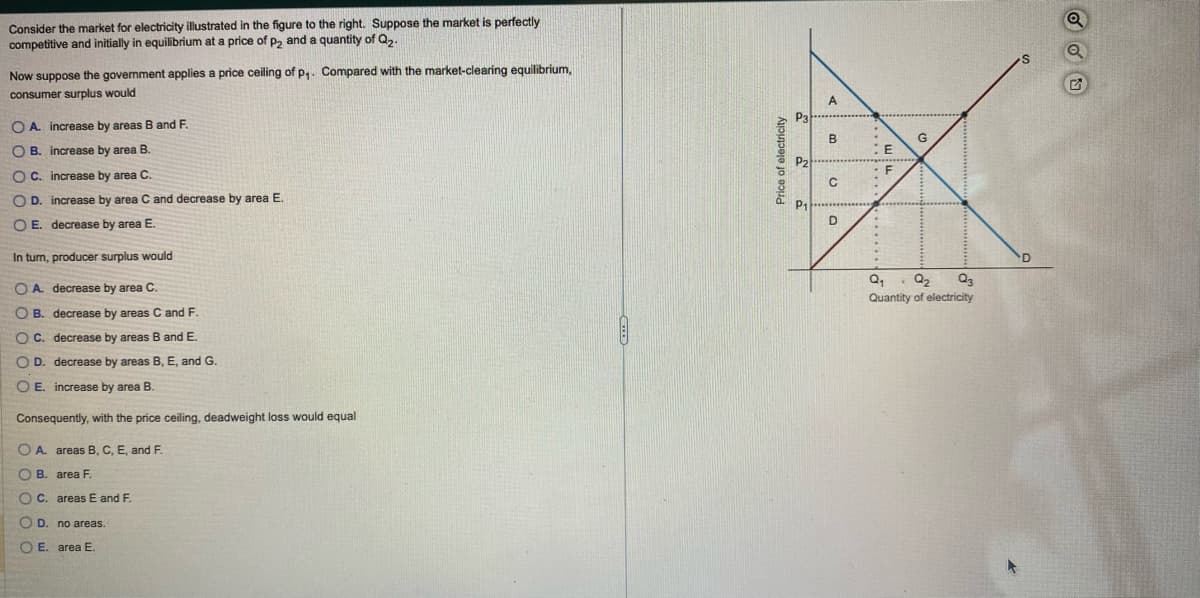mpetitive and initially in equilibrium at a price of p₂ and a quantity of Q₂. w suppose the government applies a price ceiling of p₁. Compared with the market-clearing equilib sumer surplus would A. increase by areas B and F. B. increase by area B. C. increase by area C. D. increase by area C and decrease by area E. E. decrease by area E.
mpetitive and initially in equilibrium at a price of p₂ and a quantity of Q₂. w suppose the government applies a price ceiling of p₁. Compared with the market-clearing equilib sumer surplus would A. increase by areas B and F. B. increase by area B. C. increase by area C. D. increase by area C and decrease by area E. E. decrease by area E.
Principles of Economics (MindTap Course List)
8th Edition
ISBN:9781305585126
Author:N. Gregory Mankiw
Publisher:N. Gregory Mankiw
Chapter7: Consumers, Producers, And The Efficiency Of Markets
Section: Chapter Questions
Problem 6PA
Related questions
Question
please help me answer all 3 multiple choice questions

Transcribed Image Text:Consider the market for electricity illustrated in the figure to the right. Suppose the market is perfectly
competitive and initially in equilibrium at a price of p₂ and a quantity of Q₂.
Now suppose the government applies a price ceiling of p₁. Compared with the market-clearing equilibrium,
consumer surplus would
OA increase by areas B and F.
OB. increase by area B.
OC. increase by area C.
OD. increase by area C and decrease by area E.
O E. decrease by area E.
In turn, producer surplus would
OA. decrease by area C.
OB. decrease by areas C and F.
OC. decrease by areas B and E.
OD. decrease by areas B, E, and G.
OE. increase by area B.
Consequently, with the price ceiling, deadweight loss would equal
O A. areas B, C, E, and F.
OB. area F.
OC. areas E and F.
OD. no areas.
OE. area E.
Price of electricity
P3
P₂
P₁
A
B
C
D
E
F
G
Q₁
Q3
. Q₂
Quantity of electricity
S
D
Expert Solution
This question has been solved!
Explore an expertly crafted, step-by-step solution for a thorough understanding of key concepts.
Step by step
Solved in 5 steps

Knowledge Booster
Learn more about
Need a deep-dive on the concept behind this application? Look no further. Learn more about this topic, economics and related others by exploring similar questions and additional content below.Recommended textbooks for you

Principles of Economics (MindTap Course List)
Economics
ISBN:
9781305585126
Author:
N. Gregory Mankiw
Publisher:
Cengage Learning

Principles of Microeconomics (MindTap Course List)
Economics
ISBN:
9781305971493
Author:
N. Gregory Mankiw
Publisher:
Cengage Learning

Principles of Macroeconomics (MindTap Course List)
Economics
ISBN:
9781285165912
Author:
N. Gregory Mankiw
Publisher:
Cengage Learning

Principles of Economics (MindTap Course List)
Economics
ISBN:
9781305585126
Author:
N. Gregory Mankiw
Publisher:
Cengage Learning

Principles of Microeconomics (MindTap Course List)
Economics
ISBN:
9781305971493
Author:
N. Gregory Mankiw
Publisher:
Cengage Learning

Principles of Macroeconomics (MindTap Course List)
Economics
ISBN:
9781285165912
Author:
N. Gregory Mankiw
Publisher:
Cengage Learning

Essentials of Economics (MindTap Course List)
Economics
ISBN:
9781337091992
Author:
N. Gregory Mankiw
Publisher:
Cengage Learning

Principles of Economics, 7th Edition (MindTap Cou…
Economics
ISBN:
9781285165875
Author:
N. Gregory Mankiw
Publisher:
Cengage Learning

Principles of Macroeconomics (MindTap Course List)
Economics
ISBN:
9781305971509
Author:
N. Gregory Mankiw
Publisher:
Cengage Learning